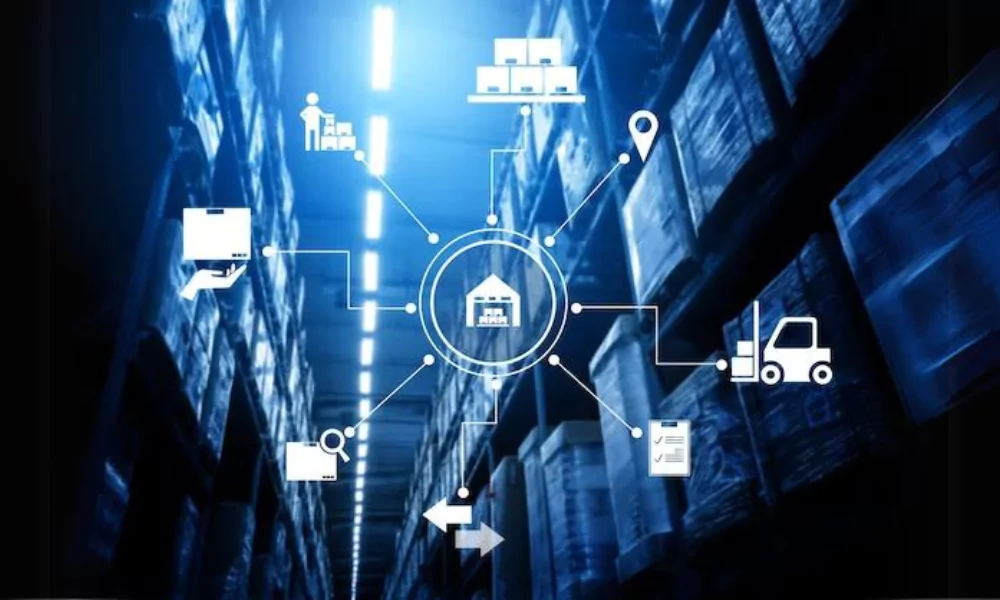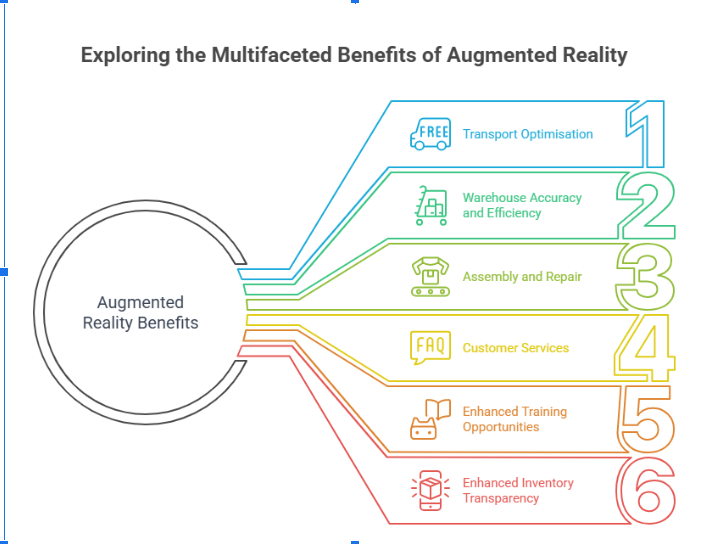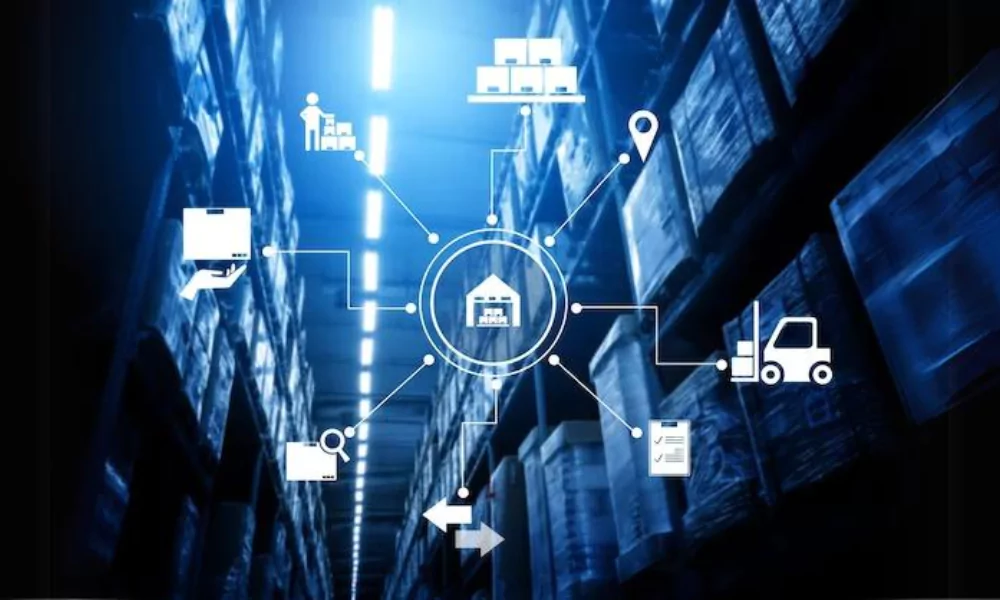
With the continuous evolution of automation, businesses also need advanced systems to stay ahead of the game. Technology is taking over various aspects of businesses including the supply chain process. One such part is Augmented Reality or AR. We are now in the era of Technology 4.0. In this era, technology plays a transformative role that is redefining traditional supply chain management practices. So, we shall take a look at the relation and phenomenon of “augmented reality supply chain management”.
Let’s explore its profound implications, benefits, and challenges· From enhancing warehouse operations to revolutionising inventory management and order fulfilment processes, AR offers a spectrum of possibilities.
We’ll navigate through its applications across various industries, highlighting real-world examples of how businesses are leveraging AR to optimise efficiency, accuracy, and agility in their supply chains· Join us on this journey as we unravel the dynamic synergy between augmented reality and the next phase of technological evolution in SCM·
“Augmented Reality Supply Chain Management”: The Connection
With the help of AR technology logistics and supply chain management are getting real-time and contextual information. With this, they can make more informed decisions and streamline supply and demand.
The technologies of augmented reality supply chain management are ever-evolving. Let’s take a look at the current popular ones.
1. Improved Warehouse Management
With the help of AR, workers can enhance warehouse operations. They can do this owing to their access to real-time information on inventory levels, item location and order fulfilment· AR-enabled smart glasses can display digital instructions and data that help workers pick and pack items more efficiently and accurately·
It t can also help to reduce the need for printed documents and labels· This saves time and reduces errors· As per a report in DHL, AR can help to reduce errors in warehouse picking by up to 40% and improve productivity by up to 25%· Companies like GE, Boeing and DHL are currently using AR-enabled smart glasses to enhance their warehouse operations·
2. Enhanced Training and Safety
Augmented Reality (AR) offers a multifaceted approach to enhancing training and safety within the workplace· By overlaying instructional videos and images onto the work environment, augmented reality supply chain management aids in training workers on new equipment, processes, and safety protocols, improving learning retention and efficiency·
Furthermore, AR can highlight potential hazards, offering real-time guidance on avoidance strategies, ultimately reducing workplace accidents· A survey conducted by Capgemini revealed that 82% of logistics companies anticipate AR to enhance safety measures and minimise incidents·
Walmart’s implementation of augmented reality supply chain management for training purposes resulted in a notable 10-15% improvement in task completion time and a staggering 90% reduction in training duration·
3. Delivery and Customer Service
In the domain of delivery processes and customer service, AR emerges as a game-changer, providing real-time updates on delivery routes, traffic conditions, and weather, thereby enhancing operational transparency and customer satisfaction·
Companies like UPS have already integrated augmented reality supply chain management to furnish customers with accurate delivery status updates and estimated arrival times· Projections indicate that by 2025, the logistics industry could generate $30 billion in revenue from AR applications·
4. Real-Time Data
Moreover, AR’s real-time data capabilities significantly bolster efficiency and accuracy in logistics and supply chain management· By furnishing workers with up-to-date information on inventory levels, order statuses, and other metrics, AR empowers informed decision-making and rapid issue resolution·
According to a survey by DHL, 69% of logistics companies affirm that AR positively impacts warehouse operations’ efficiency and accuracy·
As we can see many companies are already harnessing the use of augmented reality supply chain management. This means that there are multiple advantages that AR brings as one of the popular trends in supply chain management. So, without adieu let’s see the advantages of having AR industrial applications.
Benefits of Augmented Reality

Here are a few augmented reality applications for warehouse logistics that help supply chain streamline their operations:
1. Transport Optimisation
This is an integral part of the businesses. Companies have to ship their products to customers across the world. Along with the cost incurred on the shipment, there is also the need for intensive maintenance to trace and track every single shipment.
AR software can eliminate the need for physical cargo lists and manual tracking systems. AR software alerts workers and instructs them on step-by-step container loading and tracking systems. The AR-enabled wearables can also simplify dynamic traffic support and last-mile delivery for parcel handling, loading and distribution.
2. Warehouse Accuracy and Efficiency
One of the major advantages of Augmented Reality or AR in supply chains is how it improves warehouse efficiency and accuracy. It overlays digital information onto physical environments. AR provides real-time updates on inventory levels, item locations and order statuses.
This allows workers to locate and pick items more efficiently, reducing errors and enhancing overall productivity. Additionally, AR-guided workflows streamline processes such as inventory management, order fulfilment, and logistics, leading to turnaround times and customer satisfaction.
Overall, AR optimises warehouse operations by enhancing visibility, precision, and speed, ultimately driving cost savings and competitive advantage in the supply chain.
3. Assembly and Repair
AR glasses with enhanced image recognition techniques enable fault detection and correction in heavy machines used in sorting and repackaging goods. These glasses allow the user to inspect machines and identify mechanical or structural faults in them.
It allows timely maintenance of systems, avoiding any major malfunctioning or delay in the supply chain. Additionally, AR-powered glasses can provide instructions to fix and repair any mechanical error with the help of live tutorials.
4. Customer Services
AR-enabled parcel applications allow customers to track their shipments from the warehouses to the doorstep. The applications also give the user other details of consignment like size, weight, volume and price.
Uch an application also provides various pricing and insurance options. Consumers can track their products when it is out for delivery or replacement. They can get real-time insights on the refund status, if any.
The globalisation of supply chain management and the complexities of the process have made automation necessary. Companies understand the importance of implementing augmented reality supply chain management.
5. Enhanced Training Opportunities
Companies can use digital tools to mimic real-world situations. Digital overlays and interactive simulations representing realistic scenarios and situations can give trainees and new hires more effective learning opportunities.
As companies continue remote work, employers can do more than provide a guide handbook. Using AR they can remotely train employees across supply chain outlets.
6. Enhanced Inventory Transparency
Augmented Reality supply chain management (AR) offers enhanced insights and increased oversight into inventory levels, movement patterns, and customer purchasing behaviours. Integrating virtual experiences with inventory data through AR-enabled devices can significantly enhance awareness of stock levels.
The imperative to attain such control and visibility over inventory is paramount for many industry players. This is significant in case of demand fluctuations. With these capabilities, businesses could have responded more effectively and efficiently to evolving market dynamics.
Conclusion
Augmented Reality (AR) is revolutionising supply chain management in the era of Technology 4·0. By offering real-time insights, improving warehouse operations, enhancing training, and boosting customer service, augmented reality supply chain management presents a myriad of benefits. As businesses embrace AR technology, they are poised to gain a competitive edge in the dynamic landscape of supply chain management· To learn more about it, visit Qodenext.
FAQs: Augmented Reality Supply Chain Management
1.How does AR enhance inventory visibility and control within the supply chain?
AR overlays digital information onto the real-world environment, allowing for real-time data visualisation of inventory levels, movement, and customer behaviour, enhancing visibility and control throughout the supply chain·
2.What technologies are integral to implementing AR in supply chain management?
Integral technologies include AR-enabled devices like smartphones or tablets, robust data analytics platforms, and cloud computing infrastructure for seamless integration and processing of inventory data·
3.What are the types of AR in the supply chain?
There are marker-based AR, markerless AR, and projection-based AR, each offering unique features and applications for enhancing inventory management and logistics operations·
4.What are the potential benefits of AR technology in supply chain?
AR technology might lead to better inventory accuracy, reduced errors in picking and packing, increased operational efficiency, enhanced worker productivity, and ultimately, cost savings and better customer satisfaction·
5. How does AR improve employee performance and productivity in logistics operations?
AR provides workers with real-time, step-by-step visual instructions through smart glasses or mobile devices. This reduces manual errors, accelerates task completion, and enhances overall productivity, especially during complex warehouse operations like picking, packing, and sorting.
6. What are the challenges companies face while adopting AR in supply chain management?
Some major challenges include high implementation costs, employee resistance to new technology, data security concerns, and the need for strong network connectivity and system integration with existing ERP or warehouse management systems.
7. Can AR be integrated with other technologies like AI or IoT for supply chain optimisation?
Yes, AR works best when combined with technologies such as AI, IoT, and machine learning. For instance, IoT sensors provide real-time data, while AI analyses this data to optimise decisions, and AR visualises the insights for on-ground teams to act quickly and accurately.
8. What is the future of AR in supply chain management?
The future of AR in supply chain management looks promising with advancements in wearable tech, 5G connectivity, and digital twins. These innovations will make AR more immersive and accessible, enabling fully connected, intelligent, and autonomous supply chain ecosystems.







